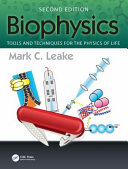

Most ebook files are in PDF format, so you can easily read them using various software such as Foxit Reader or directly on the Google Chrome browser.
Some ebook files are released by publishers in other formats such as .awz, .mobi, .epub, .fb2, etc. You may need to install specific software to read these formats on mobile/PC, such as Calibre.
Please read the tutorial at this link: https://ebookbell.com/faq
We offer FREE conversion to the popular formats you request; however, this may take some time. Therefore, right after payment, please email us, and we will try to provide the service as quickly as possible.
For some exceptional file formats or broken links (if any), please refrain from opening any disputes. Instead, email us first, and we will try to assist within a maximum of 6 hours.
EbookBell Team

0.0
0 reviewsThe book first presents the historical background, concepts, and motivation for using a physical science toolbox to understand biology. It then familiarizes undergraduate students from the physical sciences with essential biological knowledge.
The text subsequently focuses on experimental biophysical techniques that primarily detect biological components or measure/control biological forces. The author describes the science and application of key tools used in imaging, detection, general quantitation, and biomolecular interaction studies, which span multiple length and time scales of biological processes both in the test tube and in the living organism.
Moving on to theoretical and computational biophysics tools, the book presents analytical mathematical methods and numerical simulation approaches for tackling challenging biological questions including exam-style questions at the end of each chapter as well as step-by-step solved exercises. It concludes with a discussion of the future of this exciting field.
Future innovators will need to be trained in multidisciplinary science to be successful in industry, academia, and government support agencies. Addressing this challenge, this textbook educates future leaders on the development and application of novel physical science approaches to solve complex problems linked to biological questions.
Features:
Provides the full, modern physical science toolbox of experimental, theoretical, and computational techniques, such as bulk ensemble methods, single-molecule tools, live-cell and test tube methods, pencil-on-paper theory approaches, and simulations.
Incorporates worked examples for the most popular
…